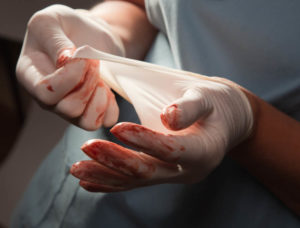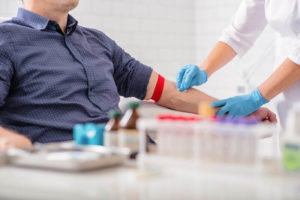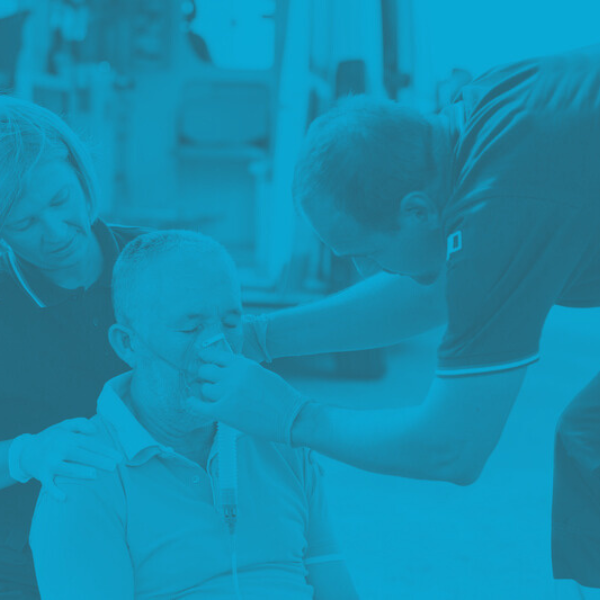Protocols for Bloodborne Pathogens (BBP)
Protocols for Bloodborne Pathogens (BBP)

by Greta Kviklyte
Life Saver, AMC
Co-authored by Kim Murray, RN, M.S.
posted on Feb 12, 2021, at 5:55 am
Bloodborne pathogens (BBP) pose a substantial risk for both healthcare professionals and their patients. For this reason, it is important for all healthcare professionals to be aware of the proper protocols that must be followed when dealing with bloodborne pathogens. Protocols are established to reduce the risk of exposure to infectious agents when handling blood and other bodily fluids, as well as to reduce the risk of infection when someone has already been exposed to a contaminated fluid.
We offer Online Bloodborne Pathogens Certification
Defining BBP
Bloodborne pathogens include all potentially infectious agents, such as bacteria and viruses, that are present in human blood and other bodily fluids. Bloodborne pathogens may also be found in human tissue or organs. Although many different pathogens can cause disease when transmitted through blood and other fluids, the pathogens that cause the most concern are Hepatitis C, Hepatitis B and Human Immunodeficiency Virus. While some bloodborne pathogens cause infections that can be cured entirely, others cause chronic infections that may affect the exposed individual for the rest of their life.

Bloodborne pathogens are most commonly transmitted in a healthcare setting when someone is accidentally cut or punctured with a contaminated sharp object. These pathogens may also be transmitted when contaminated fluids come into contact with broken skin or exposed mucous membranes. Pathogens may be transmitted when fluids splash onto a healthcare worker or patient. They may also be transmitted if the individual touches the fluids and then touches their eye, nose or mouth.
Basics of BBP Protocols
There are several steps healthcare providers can take to protect themselves and their patients from the danger of infection agents that may be present in blood or bodily fluids. These strategies are all designed to reduce the risk of infection transmission, but some risk is always present even when protocols are followed properly.
Some of the strategies used to protect against BBP include:
1. Following Standard Precautions. – Healthcare professionals should treat all blood and bodily fluids as though they are infectious, even if they are believed to be free of contaminants, to maximize safety and minimize the risk of infection. This means that the standard precautions listed below should always be followed, even if healthcare professionals are treating patients without a known bloodborne infection.
2. Wearing Personal Protective Equipment. – One of the most important strategies used to protect against bloodborne pathogens is wearing personal protective equipment. These specialized devices create an extra barrier between the healthcare professional’s body and the potentially infectious bodily fluids. Examples of personal protective equipment that may be worn include goggles, masks, gowns, face shields, and gloves. This equipment should be used any time a healthcare professional has the potential to come into contact with blood or other bodily fluids.
Different forms of personal protective equipment may be recommended in different situations. Healthcare professionals should be aware of which pieces of equipment are necessary in every situation. They should also understand how to wear these devices properly, as well as how to sanitize or dispose of them appropriately after use.
3. Practicing Proper Hygiene – Another important strategy that can be used to reduce the risk of infection involving bloodborne agents is proper hand hygiene. Healthcare professionals should wash their hands prior to touching a patient, before beginning a clean procedure, after any risk of exposure to bodily fluids, after touching patients, and after touching anything in the patient’s area. Healthcare professionals can clean their hands using soap and water or waterless hand sanitizers.
Washing the hands with soap and water is recommended when dealing with potential GI contaminants, such as norovirus. In these cases, waterless hand sanitizer will not be as effective.
4. Using Safe Medical Devices – Certain devices have been developed to reduce the risk of infection transmission through bloodborne pathogens. Examples include safe needle devices and needleless systems that are less likely to accidentally puncture personal protective equipment and/or the skin. Healthcare professionals should not only have access to these devices, but they should also be trained to use them properly in order to maximize their effectiveness.
5. Proper Disposal of Dangerous Materials or Substances – When disposing of any item, substance, or material that may be contaminated with bloodborne pathogens, medical professionals must take precautions and follow the appropriate protocols. For example, materials that are not considered sharps but may be contaminated with blood or other infectious substances should typically be placed in an infectious waste container. In most cases, these containers are red in color. Sharps, such as scalpels or syringes, should be placed in an approved sharps container designed to receive these items without risking injury to the user.
6. Obtaining appropriate vaccinations – Healthcare professionals can protect themselves against certain bloodborne pathogens by obtaining the appropriate vaccinations. Most institutions will require healthcare professionals to have evidence of these vaccinations on file. Healthcare professionals should keep up with all recommended vaccines to ensure their risk of infection is as low as possible.
Dealing with Exposures to BBP
 Even when healthcare professionals are taking precautions, exposures to bloodborne pathogens can sometimes occur. When an exposure occurs, the healthcare professional is at risk of developing an associated infection or illness. When a healthcare professional has been exposed to a substance that may have contained bloodborne pathogens, certain steps should be taken in order to limit the risk of infection as much as possible.
Even when healthcare professionals are taking precautions, exposures to bloodborne pathogens can sometimes occur. When an exposure occurs, the healthcare professional is at risk of developing an associated infection or illness. When a healthcare professional has been exposed to a substance that may have contained bloodborne pathogens, certain steps should be taken in order to limit the risk of infection as much as possible.
Immediate Steps
Some of the steps healthcare providers should take immediately after a possible exposure to bloodborne pathogens include:
1. Wash the skin. – If any skin surfaces were exposed to the substance in question, wash them immediately and thoroughly with soap and water.
2. Clean the eyes. – If potential contaminants have come into contact with the eyes, healthcare professionals should use sterile saline or clean water to irrigate them. A significant amount of water or saline should be used to ensure that the eyes are cleaned as thoroughly as possible.
3. Clean and the mouth and nose. – If the healthcare professional’s mouth and/or nose was involved in the incident, water and/or mouthwash should be used for cleaning. These areas should be cleaned as thoroughly as possible.
Reporting the Incident
In addition to taking the initial steps to remove as much of the contaminated substance from the body as possible, it is also important for healthcare professionals to follow the appropriate protocol for reporting the incident. In most cases, the injury should be first reported to the healthcare professional’s supervisor. The healthcare professional should also seek medical treatment as soon as possible. Documentation may need to be completed to ensure the incident has been recorded and handled properly.
Follow-Up After Exposure to Bloodborne Pathogens
After there has been a potential exposure to bloodborne pathogens, most institutions will require healthcare professionals to adhere to a specific follow-up protocol. This will often involve testing to determine whether the pathogen in question has caused an infection. The results of these tests will indicate whether any treatment is needed. If the first test conducted does not show any evidence of infection, many institutions will conduct subsequent tests at specific intervals to make sure that an infection does not later develop.
If the appropriate amount of time passes with no positive test results, the healthcare professional will typically be released from follow-up, although records of the incident will remain on file. If testing eventually shows evidence of an infection, the healthcare professional will not be released from this protocol and will instead receive treatment for the illness contracted.
Patient Exposure to Bloodborne Pathogens
In most cases, unintended exposure to bloodborne pathogens affects healthcare workers. However, it is also possible for patients to be exposed to bloodborne pathogens when healthcare workers are careless or through simple accidents. When a patient is unintentionally exposed to blood or another bodily fluid that could contain infectious agents, the protocol followed is similar to the steps followed when a healthcare worker is exposed. Immediately after the exposure, the affected areas should be cleaned using the appropriate methods. For example, if the patient’s eyes were affected, they should be thoroughly irrigated immediately.
In most cases, a formal report of the incident will be filed, and the patient will receive medical attention. Testing will often be conducted at regular intervals to monitor the patient for a developing infection. If evidence of an infection is found, the patient will be treated.
The Importance of Proper Training
Coming into contact with bloodborne pathogens can be dangerous and even life-changing. For this reason, it is essential for every healthcare professional who has the potential to be exposed to bloodborne pathogens to understand how to protect themselves in these situations. One of the best ways to learn about the strategies, protocols and tools used to protect against bloodborne pathogens is formal training. In addition, formal training programs teach healthcare professionals how to better protect their patients from accidental exposure to bloodborne pathogens, as well as how to respond in situations where an exposure may have occurred.
The procedures used to handle bloodborne pathogens can be complicated. In order to be properly prepared, healthcare professionals need to understand:
-
- What situations put them at risk of coming into contact with bloodborne pathogens.
- Why bloodborne pathogens are dangerous.
- What equipment they should use to reduce the risk of contact with bloodborne pathogens.
- What procedures should be used to reduce the chances of infection when an exposure occurs.
- What procedures should be followed to monitor for signs of an infection after an exposure occurs.
- How to dispose of contaminated sharps and non-sharp materials.
- How to recognize potentially contaminated materials.
Learning all of this information can seem overwhelming. However, a high-quality bloodborne pathogen training program will provide all of the knowledge and skills healthcare professionals need. Not only are these programs valuable to healthcare workers, but they are often required as a condition of employment. Most employers in the healthcare industry require every employee who has the potential to come into contact with blood and other bodily fluids to obtain a bloodborne pathogens certification. This certification must also be renewed periodically to ensure that the healthcare professional is always prepared to deal with this sensitive matter.
Who Needs BBP Training?
BBP training is recommended for any individual who could come into contact with human blood, bodily fluids or tissue as a part of their employment. In most cases, this type of training will be required before an employee will be permitted to work in a situation that could expose them to bloodborne pathogens.
How to Obtain BBP Certification
If you are a healthcare professional who needs to obtain or renew BBP certification, you simply need to take an appropriate course. These courses can be taken online or in person, depending on your preferences. In light of the pandemic, as well as the convenience and other benefits of online study, many healthcare professionals are now choosing to take their certification courses over the internet.
Advanced Medical Certification offers a BBP Certification course that can be completed entirely online in your own time. This course qualifies you for three Category 2 CME credits and allows unlimited exam retakes. Our certifications are accepted by most employers. If your employer refuses to accept your certification, you can request a full refund of any fees you paid for the course. Contact us today to learn more or to get started.
How are you protecting yourself? Share with us.



